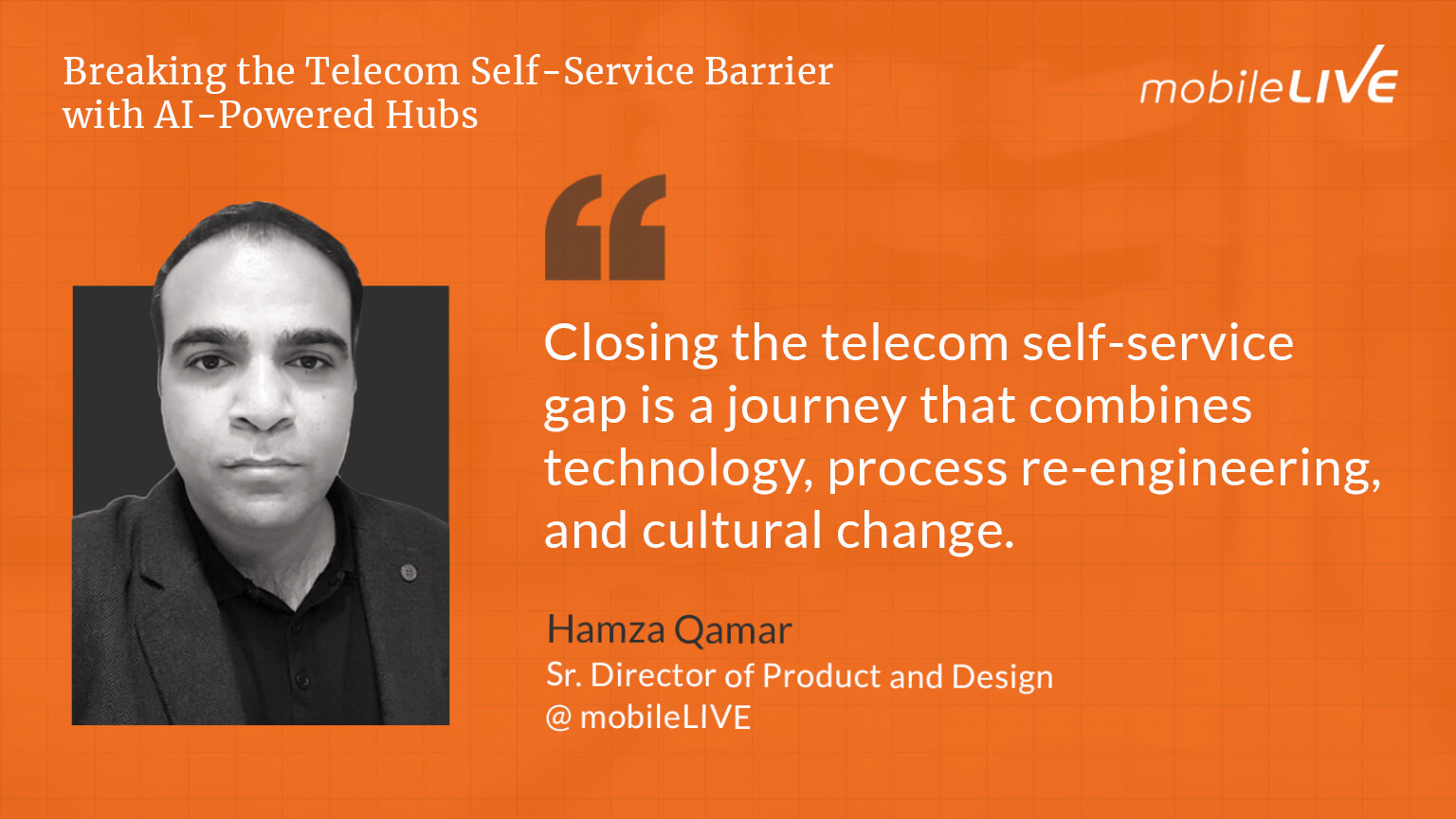
Jump To Section
- 1 The Cost of the Telecom Self-Service Gap
- 2 Root Causes Holding the Telecom Industry Back
- 3 The AI-Powered Self-Service Hub Vision
- 4 Measuring and Governing Self-Service Success: 8 Key Metrics
- 5 The Transformation Roadmap to Close the Self-Service Gap
- 6 Final Takeaway: How Telecom Operators Can Close the Self-Service Gaps
- 7 FAQs
Telecom operators have invested heavily in improving their telecom self-service portals, deploying chatbots, and redesigning their mobile apps, yet customers still pick up the phone to call an agent for help.
Despite aggressive digital transformation across the telecom industry, call volumes remain stubbornly high. In fact, McKinsey reports that 57% of telecom support leaders expect them to rise.
This is a costly problem to solve: according to CustomerGauge, nearly 39% of telecom subscribers churn due to poor support experiences. Simply put, traditional self-service has not delivered on its promise, creating a gap between telcos’ digital ambitions and customers’ actual behavior.
Paradoxically, customers, even digital-native young adults, often prefer live phone assistance for support. In a recent survey of 3,500 consumers, respondents of all ages ranked calling a live agent among their most preferred support channels, including Gen Z (ages 18 to 28). In fact, Gen Z customers were found to be 30–40% more likely to call for service than millennials, placing phone calls as often as baby boomers. This occurs despite surveys indicating that 75% of Gen Z and 62% of millennials claim to prefer self-service if available, according to a survey by Gartner. The reality is that when digital tools don’t fully resolve an issue, customers quickly reach for the phone.
The persistence of high call volumes signals a “self-service barrier” in telecom.
In this article, we’ll dissect why the telecom industry, despite its significant digital investment, continues to struggle with high support call volumes. You’ll learn what’s really causing the self-service barrier, why customers still prefer to call, and most importantly, how to break through that barrier using AI-powered self-service hubs, highlighting how telecom leaders can drive down costs, increase customer loyalty, and modernize support operations—all while positioning their companies at the cutting edge of digital service.
The Cost of the Telecom Self-Service Gap
For North American telecoms, especially in competitive urban markets like Toronto, New York, and Vancouver, the gap between customer expectations and actual self-service experiences is more than an inconvenience—it’s a measurable threat to profitability. This digital disconnect is a major contributor to customer dissatisfaction.
The consequences go beyond churn. Poor self-service experiences drive up operational costs by pushing customers toward high-cost live support channels. A single voice call can cost multiple dollars to resolve, compared to mere cents for a successful AI-driven interaction. Meanwhile, the opportunity cost is just as damaging: a customer stuck on hold is not one who can be upsold or retained through proactive, digital-first engagement.
Digital failures also sabotage brand loyalty. According to Sprinklr, 78% of consumers have abandoned a purchase due to poor service. Conversely, Salesforce data shows that 88% of customers are more likely to stay loyal to companies that provide good service. This gap in service quality is a direct threat to competitive differentiation in an industry where margins are already razor-thin.
Worse still, inconsistent digital experiences erode customer trust. A chatbot that fails to understand a billing issue or an app that redirects users to call support defeats the purpose of a “digital-first” strategy. As a result, even digitally native generations default to calling, undoing years of investment in automation and customer journey orchestration.
In short, the self-service barrier is not a UX problem. It’s a business performance problem. And the telecoms that move quickly to close it will be better positioned to reduce costs, improve loyalty, and capitalize on emerging AI-powered service opportunities.
Customers encounter friction online, confusing menus, incomplete information, chatbots that can’t handle complex questions, and end up calling for a human fix. Telco customers now use digital channels far more than before but often come away disappointed by the experience.
This digital experience gap directly impacts the bottom line: telecoms’ failure to deliver excellent online service hurts customer acquisition and retention, with 78% of consumers saying they have abandoned a purchase due to a poor service experience.
On the flip side, 88% of customers say good service makes them more likely to remain loyal, according to Salesforce.
The stakes are clear: breaking the self-service barrier is now mission-critical for telecom providers to reduce costs, retain subscribers, and meet the high expectations set by digital-native industries.
Root Causes Holding the Telecom Industry Back
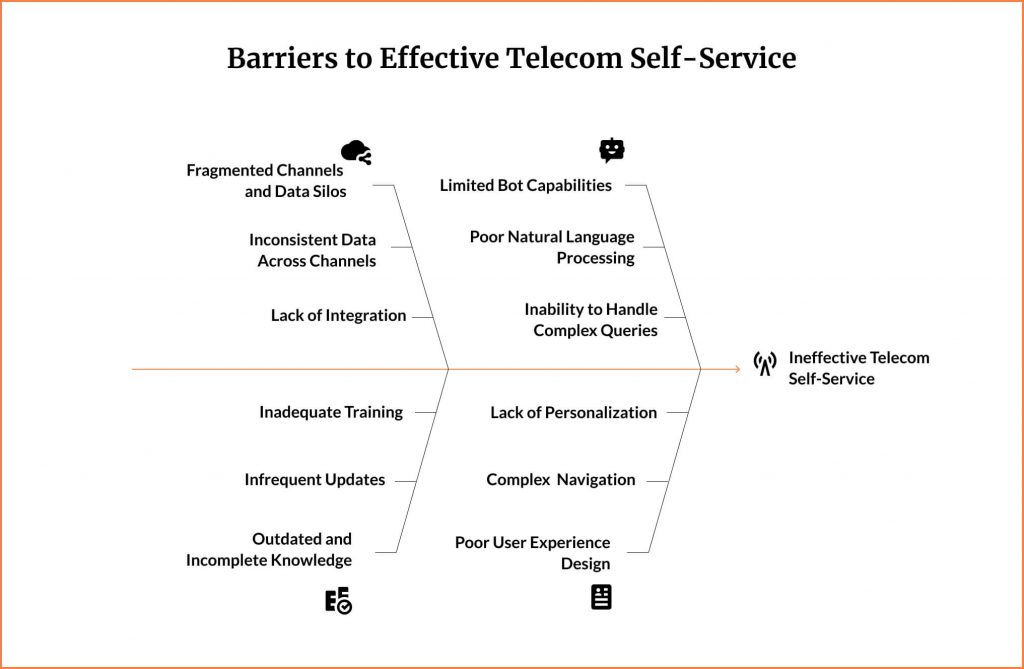
Several underlying factors have prevented telecom self-service initiatives from reaching their full potential:
Fragmented Channels and Data Silos
Many telcos offer multiple support channels (apps, web, IVR, retail) that don’t share data or context. Customers often must repeat information and switch channels to solve one issue, eroding trust in “digital-first” solutions. Disconnected back-end systems mean a self-service app might not recognize a customer’s recent network outage or billing glitch, so the customer calls an agent who can see the full picture.
Outdated and Incomplete Knowledge
Self-service portals are only as good as the information they provide, yet most telecom companies admit their self-service materials are sometimes outdated. FAQs and help articles often fail to address the exact issue or use jargon customers don’t understand. This frustrates users who “tried the website/app first” only to find unclear guidance. A simple lack of a comprehensive, up-to-date knowledge base can stall even basic tasks. (Notably, when UK carrier EE deployed a clear, unified knowledge base for customers and agents, it saw customer Net Promoter Score rise by 20% (EE UK), demonstrating the impact of better knowledge tools.
Limited Bot Capabilities
Early-generation chatbots and IVR systems have been fairly rigid, capable of handling simple, scripted queries, but easily stumped by nuanced questions or multiple issues in one conversation. It’s no surprise that majority of customers say certain problems are just too complex for a chatbot to handle. Customers sense when a bot is giving a superficial copy-paste answer that doesn’t solve their issue. These limitations lead users to zero-out to an agent or hang up and call, especially for high-stakes or convoluted problems. In short, many telecom bots have not earned customers’ confidence for anything beyond basic FAQs.
Poor User Experience Design
Too often, self-service journeys are designed around internal processes rather than customer ease-of-use. Long IVR menus, cryptic error codes, non-intuitive app interfaces, and forced channel switching (e.g. “call us to complete this request”) all create friction. Telecom services can be complex (managing plans, devices, add-ons), and if the digital UX doesn’t simplify it, customers will opt for a person. Consistency is also an issue; the experience may differ drastically between the website, mobile app, and retail store. Such inconsistency and complexity cause users to lose faith in self-service, reverting to the one channel that has been historically reliable: a phone call with an agent.
Organizational and Cultural Barriers
Internally, telecom organizations have sometimes deprioritized self-service adoption in favor of other goals. Only 11% of customer care leaders in 2024 considered reducing contact volume a top priority (a sharp drop from the previous year) as per the report on the state of customer care by McKinsey. Many shifted focus to revenue generation or cost-cutting in other areas. This can mean self-service improvements and maintenance (like knowledge updates or bot training) receive insufficient resources. Additionally, siloed teams (customer care, IT, network ops) may each own pieces of the support puzzle without a unified strategy, resulting in disjointed solutions. Finally, a culture of risk aversion can slow the rollout of new AI/ML technologies in customer-facing roles, given valid concerns around reliability and brand impact. These organizational hurdles have left many carriers stuck with incremental improvements, when what’s needed is a more transformative approach to digital self-service.
The AI-Powered Self-Service Hub Vision
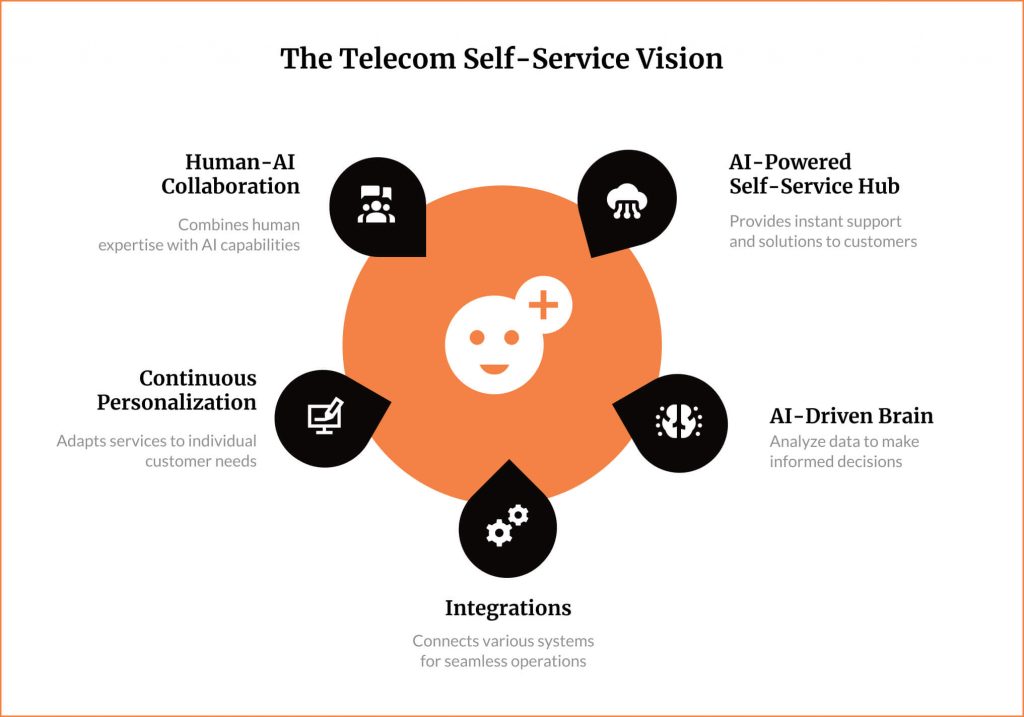
As telecom companies strive to meet rising customer expectations and reduce operational costs, the AI-powered self-service hub emerges as a transformative solution. This innovative approach combines advanced artificial intelligence technologies with seamless integration across multiple support channels, creating an intelligent and unified platform.
By leveraging AI, telecom providers can deliver faster, more personalized, and efficient customer service experiences, ultimately breaking down the long-standing barriers that have hindered self-service adoption. Let’s look into this vision, the capabilities, and benefits of implementing an AI-powered self-service hub in the telecom industry.
AI-Powered Self-Service Hub
An AI-powered self-service hub represents a vision for telecom support that is intelligent, unified, and truly customer-centric. Such a hub leverages advanced AI/ML (including generative AI) to more personalized and frictionless service across all channels with higher speed. Imagine customers interacting in natural language via chat, voice, or app, to resolve any issue, with the system dynamically understanding their intent and context. Routine questions get instant, accurate answers and 24/7 resolution without wait times.
More complex requests (like “Why did my bill increase this month?” or “My home internet is intermittently dropping”) are handled through interactive troubleshooting guided by AI, rather than static scripts. The AI hub can even execute transactions or fixes on the customer’s behalf (for example, adjusting a bill or scheduling a technician) in a seamless flow.
The result is a support experience that feels convenient and human-like, yet is powered largely by automation behind the scenes, reducing the need for customers to ever dial an agent, while boosting satisfaction through speed and consistency.
AI-Driven Brain
In this vision, all support channels feed into one AI-driven brain. Whether a customer starts with a chatbot on the website, a WhatsApp message, or an automated phone system, the AI hub accesses the same unified knowledge and customer profile, and it maintains context across touchpoints. No more repeating account details or issue descriptions as you get passed around; the AI orchestrator remembers who you are and what you need.
If a customer interacts with a virtual agent and then decides to call, the system can transfer the session to a human agent with full context, so the customer doesn’t start over. (For instance, the AI might transcribe and summarize the chatbot interaction for the live agent in real time.)
Leading telcos are already moving in this direction. Verizon, for example, introduced an AI assistant that gives human agents real-time caller history, summary profiles, and even intelligent routing to the right expert.
Similarly, T-Mobile, working with an AI platform, uses auto-generated call summaries and CRM updates to assist their agents. An AI-powered hub extends these concepts to the customer-facing side: it’s one cohesive system ensuring the customer’s journey is smooth, whether fully self-service or hybrid with human assistance.
Integrations, All the Way…
Crucially, an AI-driven support hub is backed by a deep integration into telecom business and network systems. AI can’t live in a silo to truly resolve issues, it must plug into core operational platforms (billing, provisioning, device management, etc.) as a “logic layer”.
In practice, this means the AI has real-time access to network status, usage data, account settings and can trigger service changes or updates instantly. For example, a next-gen virtual agent handling a “no internet” complaint could immediately check network outages, run line diagnostics, detect a router issue, and dispatch a replacement or technician without human intervention.
Owing to integrations, the AI hub doesn’t just inform the customer, it acts on the customer’s behalf. This level of service fulfillment is what sets an AI-powered hub apart from yesterday’s read-only self-service tools.
Continuous Personalization of Customer Experiences
Another pillar of the vision is the use of generative AI and machine learning for continuous learning and personalized customer experiences. Traditional self-service content is static, but an AI hub can dynamically generate solutions or guidance drawn from vast data.
For instance, if a unique issue starts trending, the AI can synthesize new help articles or recommendations on the fly. As an example, AI can be used to auto-summarize customer interactions to create up-to-date knowledge articles for emerging problems, thus the knowledge base evolves in real time. The hub’s AI also learns from each interaction, improving its understanding of natural language phrasing and context with every query.
Over time, it can anticipate customer needs, for example, proactively warning a customer of an outage in their area before they even inquire or suggesting an optimized family plan based on usage patterns. This means AI will increasingly be used to deliver personalized, adaptive services in real time, not just to drive efficiency. An AI-powered self-service platform embodies that shift: it blends predictive support, personalization, and conversational convenience to meet customers on their terms.
Human-AI Collaboration
Finally, the AI hub doesn’t eliminate the human touch, rather, it raises the bar for when live agents are involved. With mundane tasks handled by automation, human agents are freed to focus on high-complexity or high-empathy situations. When those cases arise, the AI hub acts like a co-pilot to the agent, providing rich context, recommendations, and even suggested responses drawn from analytics. This human-AI collaboration ensures that customers get the best of both worlds: the efficiency of automation and the emotional intelligence of a skilled agent when it truly matters.
The vision is a digital-first support model where calling a human becomes the exception rather than the norm – reserved for the most intricate or sensitive issues – yet even in those cases the AI is quietly in the background making the process faster and smarter. Achieving this vision will let telecom providers finally close the gap between what customers expect (instant, hassle-free service on-demand) and what they experience today.
A profound example of this in when our team built a specialized conversational agent that performs real-time sentiment analysis and “humanlike” negotiation for upselling and cross-selling. During support chats or calls, it gauges customer mood and adapts its tone, offering premium add-ons only when the customer is receptive, and proposing cost-saving alternatives when they’re more price-sensitive. Behind the scenes, it balances the customer’s best price against company margin rules, dynamically calculating optimal offers that maximize both satisfaction and revenue.
Measuring and Governing Self-Service Success: 8 Key Metrics
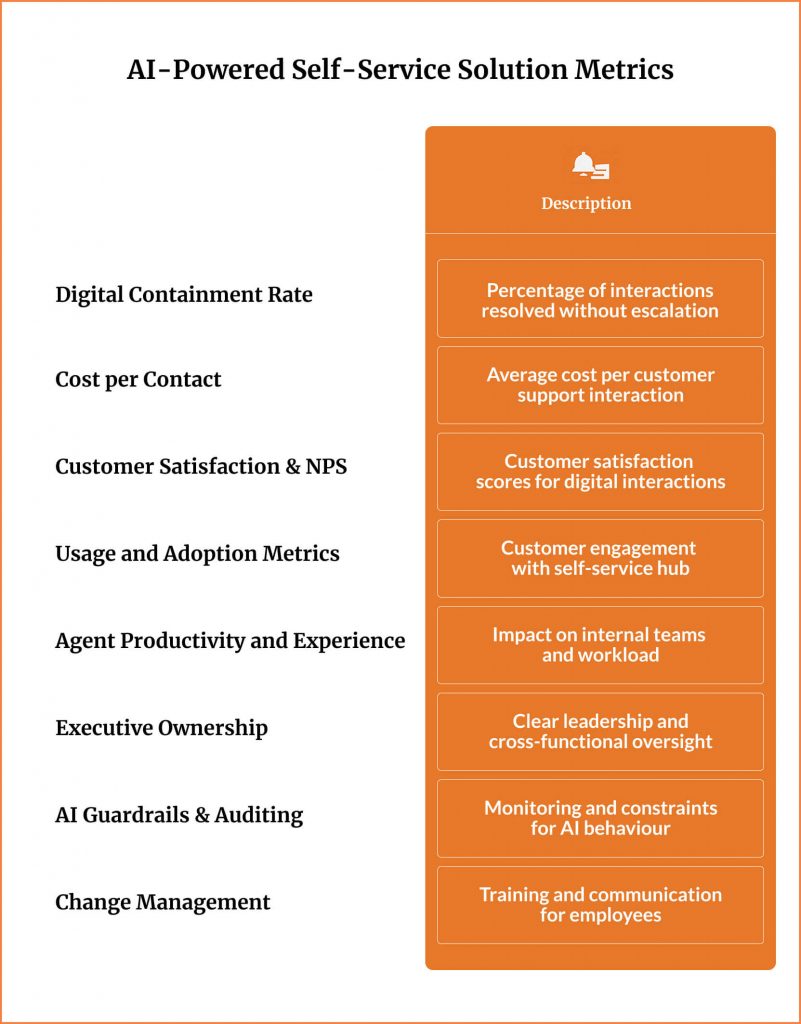
Implementing an AI-powered self-service solution is not just a technical endeavor. It requires careful measurement and governance to ensure it actually delivers on its promises in practice. Telecom executives will need to define new success metrics and oversight processes to guide their organizations through this transformation. Some of the key metrics to be included are:
1. Digital Containment Rate
The percentage of total customer interactions fully resolved through self-service (AI or automated channels) without escalating to a human agent. This is a direct indicator of whether the AI hub is closing the gap. A rising containment rate means customers are finding what they need digitally. It’s important to measure this holistically across channels.
For example, if containment rises in chat/app channels and call volume correspondingly drops, that’s a win. Conversely, if customers try self-service and still end up calling, the issue isn’t solved. Many organizations also track call deflection (how many calls were avoided due to successful self-service). The goal is a high containment/deflection rate while maintaining customer satisfaction.
2. Cost per Contact
Reducing live service volume drives cost savings, so tracking the average cost per customer support interaction over time is key. As more customers are served by AI (at pennies per interaction) instead of phone reps, this metric should decline significantly.
Executives can set targets like “reduce cost-per-contact by 30% in year one” and attribute much of that to automation. Cost metrics must be balanced with quality. A low-cost digital interaction that frustrates a customer can lead to churn, which is far more costly. Thus, cost per contact should be evaluated alongside outcome metrics like containment and NPS.
3. Customer Satisfaction & NPS
Ultimately, customer satisfaction (CSAT) and Net Promoter Score (NPS) will reveal if the AI-powered experience is truly better. It’s wise to specifically measure CSAT for digital interactions (e.g. post-chat surveys, app store ratings) and compare against traditional channels. Telecoms can look for NPS lifts attributable to AI-driven service improvements.
Other quality measures like First Contact Resolution (FCR) rate are relevant. Ideally the AI hub resolves issues on the first try, or if a handoff to an agent occurs, that combined effort still resolves the issue without repeat contacts. High FCR (whether via bot or human) correlates with higher satisfaction.
4. Usage and Adoption Metrics
To govern success, telcos should monitor how customers are actually using the new self-service hub. Key indicators include active usage rate (what percentage of customers engage with digital self-service in a given period), containment by journey type (which categories of requests customers handle via AI vs which still funnel to calls), and drop-off rates (points where users quit the self-service flow, indicating a frustration or gap). If, for example, 90% of billing inquiries are solved by the app/AI but 80% of network troubleshooting still results in a call, that pinpoints where to focus next.
Adoption also involves tracking how effectively the solution is marketed and communicated – are customers aware of the new capabilities? Measures like the number of chatbot sessions, IVR containment rate, and mobile app self-service transactions help quantify adoption. Setting clear targets (e.g. “within 6 months, 50% of all support requests should start on self-service channels”) provides a goalpost for the team.
5. Agent Productivity and Experience
A less obvious but important aspect is how the AI hub affects internal teams. Metrics here include agent handling time (are agents spending less time on calls/chats because AI is handling upfront queries or assisting in-call?), agent occupancy and capacity (can we handle more customers per agent thanks to AI augmentation?), and agent satisfaction (are employees happier now that they deal with fewer repetitive inquiries?).
If the AI hub is working, front-line staff should be less burdened by routine tier-1 questions and better equipped for complex cases, which can improve morale and enable agents to focus on value-added interactions (even sales opportunities). Governance should include monitoring these workforce impacts, since agent acceptance of AI tools is critical to success.
6. Executive Ownership
In tandem with metrics, strong governance mechanisms must be in place to steer the AI-powered transformation responsibly. This begins with clear executive ownership and cross-functional oversight. Many telecom leaders establish an AI governance committee or designate “AI champions” in each business unit to ensure the new technology aligns with company values and policies (Telefónica, for example, embedded Responsible AI Champions across its units as part of its AI governance framework).
Such governance bodies should define guidelines for ethical AI use, data privacy, and security from the outset. Given that telecom providers handle sensitive customer data, compliance with regulations (like GDPR in Europe, or PIPEDA for Canada) and protection of customer privacy are non-negotiable. AI systems, especially those leveraging customer data or automating decisions, should be reviewed for fairness and transparency. Putting an AI chatbot into production without robust governance is a recipe for trouble.
7. AI Guardrails & Auditing
Effective governance also means instituting guardrails and monitoring for the AI itself. There have been high-profile instances of AI missteps – from biased algorithms to “rogue” chatbots that respond inappropriately. Telecoms must anticipate these risks. For example, an AI support agent should have constraints to avoid toxic or biased language, and a defined escalation path to a human if it’s unsure or the customer is unhappy. Regular audits of AI interactions can help catch issues early.
Additionally, leaders should demand measurability and transparency from AI systems. As one telecom AI director put it, without the ability to test, monitor, and get quality feedback on AI performance, “you’re not going to make the right decisions” on improving it. This means investing in analytics to see how the AI is responding, where it fails, and why. It also involves maintaining human-in-the-loop processes. For instance, allowing agents or supervisors to review and correct AI outputs, and using those insights to refine the models.
8. Change Management
Lastly, governance must cover the people and change management aspects. Rolling out an AI-powered self-service hub will change workflows for customer service teams and touch many departments (IT, marketing, retail, etc.). A governance model should include training programs to upskill agents to work with AI tools, and clear communication to employees about how AI will help (not just as a cost-cutting tool, but as a way to improve customer and employee experience). It should also set policies for when human intervention is required, so staff know when to trust the AI and when to step in.
With a solid governance framework – aligning people, process, and technology – telecom companies can confidently scale their AI self-service initiatives while avoiding ethical pitfalls and ensuring a positive outcome for customers. In summary, success will be measured not just by efficiency gains, but by customer trust and business resilience earned through responsible AI use.
The Transformation Roadmap to Close the Self-Service Gap
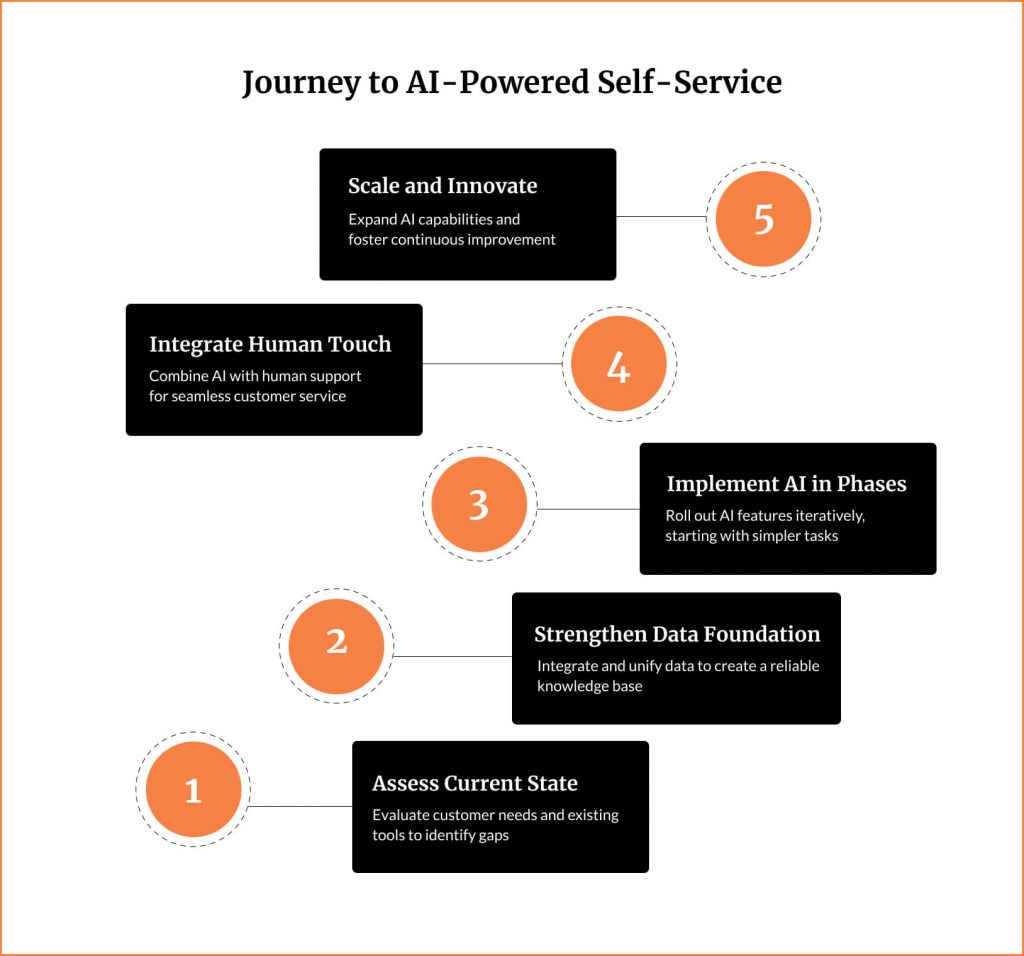
For telecom executives plotting the journey to an AI-powered self-service future, a phased roadmap can guide the transformation. Below is a step-by-step approach to closing the self-service gap and realizing the vision:
Step 1: Assess Current State and Customer Needs
Begin with a clear-eyed evaluation of why customers are still calling. Analyze contact drivers, what top issues or transactions lead to calls versus digital attempts? Gather customer feedback to pinpoint pain points in existing self-service (e.g. “the app didn’t show my data usage correctly” or “the chatbot couldn’t understand my request”).
Benchmark key stats, like containment rate and CSAT, to have a baseline. This diagnostic phase should also inventory your existing tools (IVR, app, FAQ, chatbots) and identify capability gaps. The goal is to map out the biggest gaps and opportunities. For example, you might find that a huge percentage of calls are billing disputes that could be resolved with better online billing clarity, or that device troubleshooting flows are too confusing.
Prioritize the areas that, if improved, would deflect the most calls and improve customer satisfaction. This step ensures you “solve the right problems” with AI – focusing on high-impact use cases that matter to your subscribers.
Step 2: Strengthen the Data and Knowledge Foundation
A successful AI self-service hub rests on unified, high-quality data and content. Before layering on fancy AI, invest in data integration and knowledge management. Break down silos between customer account data, network data, and support systems. Strive to create a 360° customer view that the AI (and agents) can draw on including billing history, device info, past interactions, etc.
Telecom leaders should consider implementing a central knowledge platform that serves both customers (through self-service interfaces) and agents (for assisted service), so everyone relies on the same up-to-date answers. This may involve a cleanup of existing FAQs and guides, and processes to keep them updated continuously.
Given that only 40% of service pros are fully confident in their data today (Salesforce), this step is critical. It can include modernizing IT architecture, moving to cloud-based data lakes or CRM systems that aggregate information across products and channels. The mantra here is “one source of truth”. The work to establish a solid data foundation is not glamorous, but it’s a prerequisite for AI success.
Learn more on AI-driven Knowledge Management in this detailed guide for handling queries with higher efficiency.
Step 3: Implement AI-Powered Self-Service in Phases
With the groundwork laid, begin rolling out AI-driven self-service features iteratively. A good starting point is to enhance existing digital channels with AI, for example, deploy a conversational AI chatbot on your website or messaging channels that uses natural language processing to handle common queries more effectively than rule-based bots. Ensure it’s connected to the unified knowledge base and back-end systems so it can both answer questions and perform actions (e.g. “Please upgrade my plan” → bot actually completes the change).
Start with a pilot on a specific channel or for specific use cases to gather data and customer reactions. It’s wise to train the AI on high-volume, simpler tasks first (like balance inquiries, basic troubleshooting, plan changes) to build confidence. Over time, expand its scope to handle more complex interactions as the AI learns and as you refine the conversation flows.
In parallel, upgrade your IVR to a more intelligent voice bot that can understand natural speech and intents. Many telecoms are now replacing touchtone menus with AI-driven voice assistants. Throughout implementation, use an agile approach: deploy, measure results, and refine. For instance, if the chatbot pilot shows that certain queries still confuse the AI, adjust the model or add training data before scaling up. Keep customers in the loop too. Clearly communicate new self-service features (marketing the convenience and 24/7 availability) to encourage adoption.
It’s also helpful to brand your AI assistant with a persona/name to make it more approachable (many telcos have done this, from Vodafone’s “TOBi” to Aura at Telefónica). Remember that industry peers are on the same journey, so leverage lessons from peers and consider off-the-shelf AI solutions or partnerships that can accelerate your rollout.
Step 4: Integrate Human Touchpoints and Feedback Loops
Achieving an AI-powered hub means unifying the human and AI sides of customer service. As you deploy self-service AI, work on seamless integration with live support. This includes enabling smooth handoff of chats or calls from the virtual assistant to human agents when needed, with full context transfer.
Equip your agents with AI-driven tools as well, such as an “agent assist” system that transcribes calls in real time and suggests solutions or next best actions. The goal is to eliminate the traditional gap between digital and human service.
For instance, if a customer tried solving an issue via the app but got stuck and calls in, the agent should immediately see what steps were taken and pick up from there, rather than starting fresh. Implementing a unified case tracking across channels can facilitate this.
Additionally, set up feedback loops from both customers and agents. Allow customers to easily rate the helpfulness of the virtual assistant and explain if something went wrong – this data is gold for improving the AI. Likewise, encourage agents to flag cases where the bot handed off incorrectly or could have actually handled something if it had more info; feed those insights into your training data. Consider an internal dashboard that monitors AI performance in real time (containment rates, fallback rates, customer sentiment analysis) so that your team can intervene or tweak configurations quickly.
Phase 4 is about fine-tuning the collaboration between AI and humans: use your frontline staff to train the AI (implicitly through feedback) and use AI to empower staff creating a virtuous cycle of continuous improvement. By the end of this phase, the distinction between channels should blur; customers get a consistent experience, and your support operation functions as a coordinated omnichannel system.
Step 5: Scale, Govern, and Innovate
With proven success in pilots and early deployments, it’s time to scale up the AI-powered hub and institutionalize it. This means expanding the AI capabilities to cover essentially all major customer journeys from sales inquiries to technical support and rolling it out across the customer base (including possibly IVR integration so that even phone callers first interact with the AI agent). As volume increases, ensure your governance framework (discussed earlier) is actively enforced.
At this stage, establishing an AI center of excellence or a dedicated product team for the self-service hub can be valuable to keep momentum. They would be responsible for monitoring KPIs, handling model updates, and coordinating across IT, operations, and customer care units. Govern success tightly: hold regular reviews on metrics like containment rate, CSAT, and error rates of the AI solutions. Also, continue updating training data. For example, ingest new product information or new types of customer issues into the AI’s knowledge.
Integrating multimodal interfaces (allowing customers to upload a photo during a support chat or using voice and text interchangeably) can enhance the experience. Generative AI models will continue to improve; carriers can experiment with the latest AI releases to expand what the virtual agents can do (always with appropriate testing and safeguards before full deployment).
Partnering with external innovators can help here: for example, Comcast’s LIFT Labs accelerator recently worked with startups on conversational AI solutions for telecom, yielding fresh ideas and tech that Comcast could pilot. Telecom executives should foster a culture of continuous improvement, treating the AI hub not as a one-off IT project but as a new digital product that evolves with customer needs and technology advances. By Phase 5, the organization should be in a steady state where the self-service hub is delivering tangible results like lower call volumes, higher customer satisfaction, and new revenue opportunities, and where ongoing governance and innovation keep it on the cutting edge.
To fuel rapid innovation, mobileLIVE developed an AI Discovery Framework that ingests network, usage, and support center data to pinpoint both short-term wins (e.g., high volume call drivers ripe for bot automation) and longer term opportunities (e.g., emerging customer segments primed for new service bundles). In one North American rollout, the framework identified a niche of heavy streaming users who were underserved by existing plans leading to a targeted upsell campaign that delivered increase.
Final Takeaway: How Telecom Operators Can Close the Self-Service Gaps
In summary, closing the telecom self-service gap is a journey that combines technology, process re-engineering, and cultural change. Executives in North American and global telcos alike must articulate this roadmap clearly and drive it from the top, as it cuts across traditional silos. The payoff is well worth it: a highly efficient support model, significant cost savings, and customer experience excellence that differentiates your brand in a competitive market.
By breaking through the self-service barrier with AI-powered hubs, telecom providers can finally align customer behavior with digital strategy, empowering users to get fast, smart support on their own terms, and reserving the phone lines for when they truly add value. The telecoms that succeed in this transformation will not only reduce support costs; they will earn stronger loyalty and open the door to monetizing new AI-driven services in the future.
It’s about turning customer service from a pain point into a competitive strength, using the best of AI and human support in harmony. The tools are ready, and the customer demand is there – now it’s up to telecom leaders to close the gap.
FAQs
What exactly is the “self-service barrier” in telecom, and why does it persist?
The “self-service barrier” refers to the gap between telcos’ investments in digital channels (portals, apps, chatbots) and customers’ continued reliance on phone support. It persists because existing tools often suffer from data silos, outdated knowledge bases, limited bot intelligence, confusing UX, and fragmented organizational ownership forcing customers to call when digital channels fall short.
How does an AI-powered Self-Service Hub differ from traditional chatbots or IVR systems?
Unlike rule-based bots or static IVR menus, an AIPowered Hub:
- Consolidates all channels into one “brain” with unified data and context
- Uses natural‐language understanding and generative AI to handle complex, multistep requests
- Integrates deeply with billing, network, and device systems so it can not only inform customers but also execute account changes or dispatch technicians
- Continuously learns from interactions to personalize responses and proactively surface solutions
What business metrics should telecom executives track to measure success?
Key metrics include:
- Digital Containment Rate: % of interactions resolved fully online or via AI without human handoff
- Cost per Contact: Average cost of each support interaction (should decline as automation rises)
- CSAT & NPS: Satisfaction scores for digital channels and overall brand loyalty
- First Contact Resolution (FCR): % of issues solved in one session (bot or agent)
- Usage & Adoption Rates: Share of customers engaging with selfservice vs. calling
How can telecoms overcome data silos and outdated knowledge to power an AI hub?
Begin by unifying customer account, network, and support data into a single platform (“one source of truth”). Clean up and centralize your knowledge base so both AI and agents draw from the same, uptodate FAQ and troubleshooting content. Establish clear content‐ownership processes and consider AI‐driven auto‐updates (e.g., synthesizing new help articles from trending issues) to keep your hub’s knowledge fresh.
What early wins can telcos expect when rolling out an AI-powered hub?
By phasing in AI for high-volume, straightforward tasks first (balance inquiries, plan changes, basic troubleshooting), telcos often see:
- 10–20% reduction in voice call volume within the first 3–6 months
- 15–25% increase in digital containment rate
- Improved CSAT on digital channels by 10–15 points
- Incremental revenue lifts through AI-driven upsell (e.g., mobileLIVE’s sentiment-aware agent drove a 12% ARPU increase)



